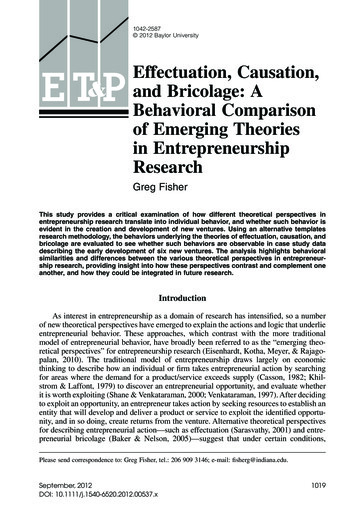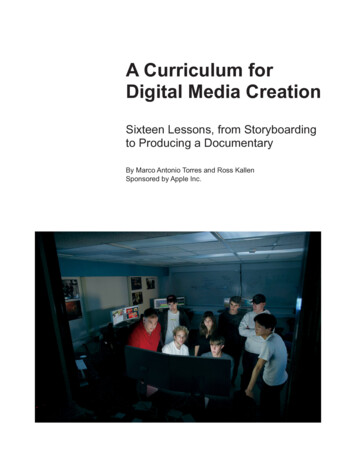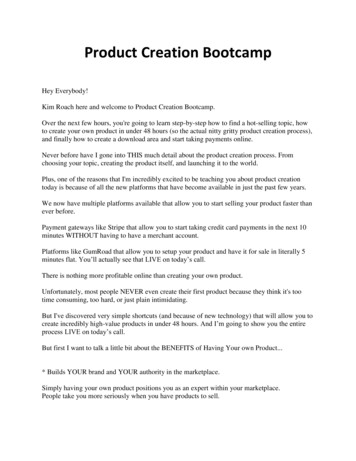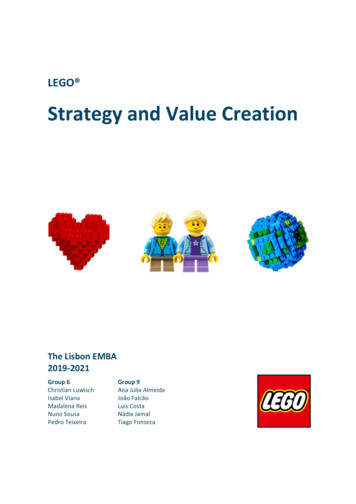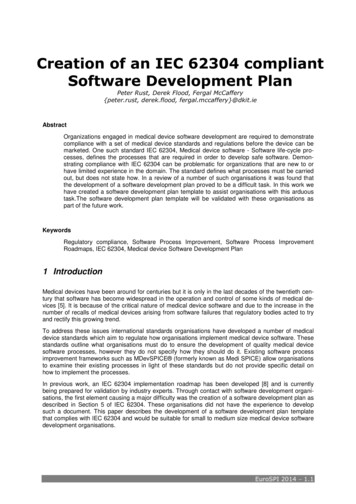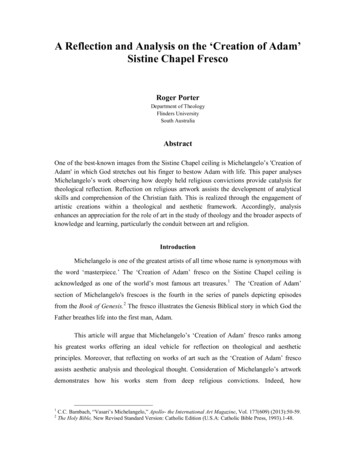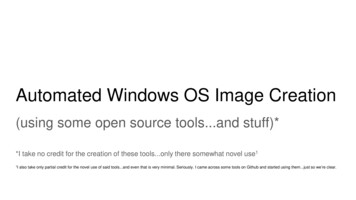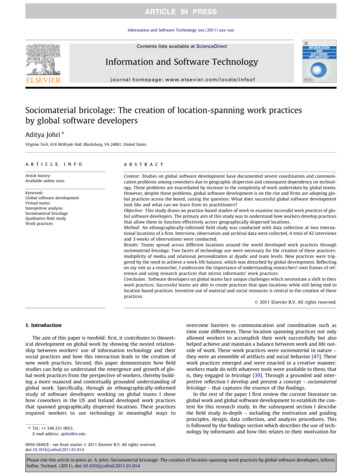
Transcription
Information and Software Technology xxx (2011) xxx–xxxContents lists available at ScienceDirectInformation and Software Technologyjournal homepage: www.elsevier.com/locate/infsofSociomaterial bricolage: The creation of location-spanning work practicesby global software developersAditya Johri Virginia Tech, 616 McBryde Hall, Blacksburg, VA 24061, United Statesa r t i c l ei n f oArticle history:Available online xxxxKeywords:Global software developmentVirtual teamsInterpretive analysisSociomaterial bricolageQualitative field studyWork practicesa b s t r a c tContext: Studies on global software development have documented severe coordination and communication problems among coworkers due to geographic dispersion and consequent dependency on technology. These problems are exacerbated by increase in the complexity of work undertaken by global teams.However, despite these problems, global software development is on the rise and firms are adopting global practices across the board, raising the question: What does successful global software developmentlook like and what can we learn from its practitioners?Objective: This study draws on practice-based studies of work to examine successful work practices of global software developers. The primary aim of this study was to understand how workers develop practicesthat allow them to function effectively across geographically dispersed locations.Method: An ethnographically-informed field study was conducted with data collection at two international locations of a firm. Interview, observation and archival data were collected. A total of 42 interviewsand 3 weeks of observations were conducted.Results: Teams spread across different locations around the world developed work practices throughsociomaterial bricolage. Two facets of technology use were necessary for the creation of these practices:multiplicity of media and relational personalization at dyadic and team levels. New practices were triggered by the need to achieve a work-life balance, which was disturbed by global development. Reflectingon my role as a researcher, I underscore the importance of understanding researchers’ own frames of reference and using research practices that mirror informants’ work practices.Conclusion: Software developers on global teams face unique challenges which necessitate a shift in theirwork practices. Successful teams are able to create practices that span locations while still being tied tolocation based practices. Inventive use of material and social resources is central to the creation of thesepractices.Ó 2011 Elsevier B.V. All rights reserved.1. IntroductionThe aim of this paper is twofold: first, it contributes to theoretical development on global work by showing the nested relationship between workers’ use of information technology and theirsocial practices and how this interaction leads to the creation ofnew work practices. Second, this paper demonstrates how fieldstudies can help us understand the emergence and growth of global work practices from the perspective of workers, thereby building a more nuanced and contextually grounded understanding ofglobal work. Specifically, through an ethnographically-informedstudy of software developers working on global teams I showhow coworkers in the US and Ireland developed work practicesthat spanned geographically dispersed locations. These practicesrequired workers to use technology in meaningful ways to Tel.: 1 540 231 0653.E-mail address: ajohri@vt.eduovercome barriers to communication and coordination such astime zone differences. These location spanning practices not onlyallowed workers to accomplish their work successfully but alsohelped achieve and maintain a balance between work and life outside of work. These work practices were sociomaterial in nature –they were an ensemble of artifacts and social behavior [47]. Thesework practices emerged and were enacted in a creative manner;workers made do with whatever tools were available to them, thatis, they engaged in bricolage [39]. Through a grounded and interpretive reflection I develop and present a concept – sociomaterialbricolage – that captures the essence of the findings.In the rest of the paper I first review the current literature onglobal work and global software development to establish the context for this research study. In the subsequent section I describethe field study in-depth – including the motivation and guidingprinciples, design, data collection, and analysis procedures. Thisis followed by the findings section which describes the use of technology by informants and how this relates to their motivation for0950-5849/ - see front matter Ó 2011 Elsevier B.V. All rights reserved.doi:10.1016/j.infsof.2011.01.014Please cite this article in press as: A. Johri, Sociomaterial bricolage: The creation of location-spanning work practices by global software developers, Inform.Softw. Technol. (2011), doi:10.1016/j.infsof.2011.01.014
2A. Johri / Information and Software Technology xxx (2011) xxx–xxxcreating work practices. I then show how the findings can be explained through the grounded theory-developed concept of sociomaterial bricolage. In the subsequent section I reflect on myresearch experiences with the aim to clarify the connectionsbetween the research process and the findings. I then discuss thelimitations of the study and outline some ideas for future work.2. Globally distributed workResearch on globally distributed work and global softwaredevelopment is a vibrant and dynamic area. However, workingacross distances is highly complex and challenging, and this hasbeen firmly established through various studies [32]. Globally distributed work has a long history dating back several centuries[40] but recent advances in information and communication technologies have changed the landscape decisively by enabling theemergence of novel organizational forms that spread the globe[28]. Although the growth and spread of distributed work in itselfis testament to its success, studies continue to show that distributed workers face many critical challenges. Problems occur in global work due to increased complexity of work that requiressignificant coordination and increased diversity of boundaries facedby workers such as temporal, contextual, disciplinary, occupational,and organizational [1]. These boundaries result in lack of mutualknowledge and common ground, which leads to misattributionsand breakdowns in communication and collaboration [16,17].Interpersonal conflict [30,31] among team members is higher andis coupled with a lack of trust among them [33]. Distribution ofteams across locations also makes them prone to subgroup formation based on locations [27] which results in ethnocentrism [18],making it hard to share knowledge and expertise [44].In particular, since distributed workers are usually unable toshare direct experiential knowledge they must rely on interactional dynamics and category membership that are mediated bytechnology. Communication in these mediated environments is a‘‘leaky process’’ [17], [p.364] and can contribute to bias, partialinformation, lack of trust, misunderstandings, and conflict, especially between people who lack mutual knowledge. The consequences of failure to establish mutual knowledge are harsh andinclude poor decision quality and productivity and less effectiveconflict resolution. Therefore, technology-enabled global workcan be seen as having contradictory effects. On the one hand itfacilitates collaboration among people with diverse skills andexpertise to tackle significant problems, on the other hand themechanism for the collaboration – use of technology – and increased team diversity results in interpersonal and organizationalbreakdowns.2.1. Global software developmentSoftware development has experienced large shifts due to theinherently digital nature of work that allows decoupling of locationand enables coordination through the use of software systems ascommunication systems [50]. This has led to distributed workbecoming the norm for software development but complicationsin global software development mirror those in other kinds of global work. In particular, increase in locations increases the complexity of work exponentially and, as Crowston et al. [19] point out,presence of boundaries is particularly problematic for softwaredevelopment as the nature of work is such that it requires drawingon knowledge from many domains spread among different developers. Software projects require ‘‘a high degree of knowledge integration and the coordinated efforts of multiple developers [19].’’These problems are exacerbated when workers are distant andunfamiliar with each other’s work and context. In particular,interpretative difficulties make it hard for team members to develop shared mental models of the developing project [26]. The additional effort required for distributed software development resultsin delays in software release compared to traditional face-to-faceteams [29], and can lead to an ineffective team [15]. Yet, eventhough global software development is prone to problems, its commercial success is a testament to the ability of firms and developersto overcome challenges and deliver products. Recent investigationsof the work practices of global software developers show thatworkers maintain the agility and flow of their practices throughthe application of situated perspectives and localized practices[2,8]. Boden et al. [8] applied Strauss’s articulation work framework to the study of global software teams and found that thework practice of developers could be characterized as a continuouseffort to renegotiate the allocation of tasks. Their study alsoshowed that although formal methods can help reduce ambiguityin the development process, these methods or tools are stronglysupported by information communication processes. Finally, theyfound that workers preferred lightweight, flexible, and easy touse tools for everyday communication and that specialized toolswere not so common in practice. Avram et al. [2] investigatedthe use of bug tracking systems across teams of distributed workers and found that local practices were shaped by the need to keepwork flowing across the locations even if this mean going againstprescribed practices of a project. They argue that the appropriateimage of technology in global software teams is of a heterogeneousassembly of systems – a view supported strongly by the CSCW tradition of workplace studies.2.2. Examining global software work practices in greater depthThe premise for this particular field study was that in spite ofproblems associated with it, global software development isexpanding rapidly and it might be prudent to learn from successfulexamples of work practices. This goal was triggered by both theoretical and pragmatic motivations. The theoretical support for thisidea grew out of recent research in social psychology where scholars are criticizing the field’s obsession with studying the failings ofhuman nature rather than learning from the positive aspects of social interaction [37]. These scholars are emphasizing a focus on thesituated understanding of cognition and social psychology [55,56].The tenacity of the human spirit and developers’ ability to buildsoftware as members of global teams is further supported by recent studies such as [2,8], discussed above, that show that anuanced understanding of global software development demonstrates the emergence of practices to support dispersed work. Ata pragmatic level, the idea for this study came from prior studiesI have undertaken, wherein informants often mentioned that inspite of the difficulties they faced, their work was completed asper requirements, met the desired quality, and often exceededexpectations. Informants expressed a desire for a more fluid workplace with fewer interruptions and breakdowns that would support their roles better, but recognized that the overall goal of theprojects was achieved.Given the overarching goal of the study to examine successfulglobal software development and the dearth of studies that focuson the positives, an in-depth examination was warranted to uncover nuanced and descriptive cases. This approach was modeledafter scholars working in the tradition of practice-based research.In the last decade, scholars have increasingly called for a focus inorganizational studies on understanding the way in which workactually gets done in organizations [5]. The ‘‘practice turn,’’ whichaims to provide a more nuanced view of work, builds on social theory and advocates a strong focus on people, routines, and situatedactivity rather than abstract processes [9,22,51,52]. As Schultzeand Boland [54] explain, ‘‘The objective of a practice-orientedPlease cite this article in press as: A. Johri, Sociomaterial bricolage: The creation of location-spanning work practices by global software developers, Inform.Softw. Technol. (2011), doi:10.1016/j.infsof.2011.01.014
A. Johri / Information and Software Technology xxx (2011) xxx–xxxapproach is to focus on what people ‘actually’ do rather than onwhat they say they do or on what they ought to be doing(p. 195).’’ In relation to examining work, this stream of research –under the umbrella term work practices – places at its core a closeattention to the actual activities of workers with the aim to understand not just the explicit but also the tacit aspects of work. Conventional views, which focus on narrow tasks and outcomes,conceptualize work as a static slice of specialized labor and jobsas pre-defined activities to be executed without ambiguity. Theseviews overlook the continuous flows of activities that comprisework and focus disproportionally on outcomes rather than on activities through which people produce those outcomes [10–12]. Inmethodological terms, ‘‘[T]he study of practice requires attentionto the mundane detail of everyday life so as to uncover the localhabits, assumptions, taken-for-granted context and tacit knowledge that members of the social group have difficulty articulating.Ethnographic research methods are particularly well suited to thestudy of practice [54], [p.194–5].’’ Therefore, an ethnographicallyinformed field study was an appropriate mode of inquiry as it allowed for descriptive data collection, which is more approachablefor understanding the interpretive aspects of an organization [21].3. Field studyThe field site for this study was a large software and hardwaretechnology organization I have given the pseudonym ‘‘Digitech.’’The firm was founded almost quarter of a century ago in the heartof Silicon Valley on the US West Coast. Digitech expanded its international operations substantially during the 1990s, with a presence in all major markets of the world and development centersacross Asia, Europe, and North America. Although the firm saw arapid growth over the first decade of its existence, becoming onethe most well known and well run firms in the world, it never fullyrecovered from the dot-com bust of the early 2000s.3.1. Access and initial days in the fieldThe access to the site was negotiated over several months. Initialcontact was made with a Vice President (VP) in the firm throughemail, followed by a conversation over the phone, a teleconferencewith the VP and her team, and subsequently a face-to-face meetingwith the VP in California. I was asked to prepare a document outlining the research objective and design which was tentatively approved. Subsequently, the VP put me in touch with anothercontact in the Human Resources (HR) department who becamethe central contact for all logistical issues and over the period ofthe field study also turned into a useful informant. This person,whom I will call Stacy, arranged a meeting with a Group Director(GD) who oversaw a large group that was distributed globally. Itraveled to California to meet with the GD and his team and to conduct the first stage of the field study. I then traveled to the site inCalifornia to collect data. During the visit I went to different officeslocated in the area, sat in on and observed some group meetings,met with informants, and took field notes. I developed an understanding of the firm and the site but was able to interview onlythe GD, the rest of the interviews did not pan out. My interviewwith the GD provided in-depth background and context of the organization, his day-to-day work, description of his team, and mostimportantly, his outlook on the project I was hoping to accomplish,in particular, his reasons for supporting the study. He explainedhow he had been with the firm for decades and at one time duringhis tenure had decided to relocate to another state within the US tomake is easy for him to raise his family. The firm decided to supporthim as a teleworker and he became one of the first employees totake on a distributed role. His experience convinced him that3distributed and virtual teams can work together and deliver products and since then he has been a proponent of geographically distributed work. To help us recruit more participants he gave uscontacts and ensured that his team, or at least some members,would participate in the study. By following up with those contacts,primarily through Stacy, I was able to schedule a week of field studyin California, followed by field study in Ireland, and then anotherround in California. This research was partially supported by Digitech and in return I shared my research results with the organization. I prepared some specific reports for them and helddebriefing sessions with some employees. The timeline for the project reported here ranged from September 2008 to February 2009.3.2. Research study and methodsThe study was conceptualized as an ethnographically-informedqualitative field study that would help uncover how successfulwork practices emerged and were sustained. The study was designed as an interview-based study supplemented with observations and unobtrusive data collection [45,65]. A semi-structuredinterview protocol was developed based on techniques identifiedby Spradley [57] and contained questions about their informants’daily routines, background, interaction with co-located and distributed colleagues, and work practices. The protocol was only looselyfollowed during the actual field study and the interviews took different directions based on the informants’ responses. Observationalfield notes formed another core component of the research design[42]. Field notes are critical for capturing the context of work – location, décor, services available to workers, and informal and formalinteractions. Field notes were supplemented with memos of myimpressions of the field site and informants. Overall, the interviewsformed the core of the data but the context to understand and interpret them came from the observation field notes and other organizational data. Another feature of the research design was to traveland collect data at different locations. A researcher’s first-handexperience with different research sites is essential for capturingcontextual knowledge of locations and to build a knowledge basethat can be used to interpret the data in a meaningfully.3.3. Data collectionThe field study was spread over 6 months and included interviews with 42 informants and observations on three different occasions at two different locations; one in the US and one in Ireland.The interviews were done either face-to-face (if the informantswere at the Ireland location or the US location) or through thephone if the informants were in other locations. Overall, the informants who were interviewed lived across six different states in theUS, and in Ireland, United Kingdom, France and Japan. Nationalitiesrepresented in the sample included American, Irish, British, French,Spanish, Polish, Indian, and Malaysian. In interviews done throughthe phone, additional questions about the informants’ locationwere added to the interview protocol. The interviews varied intheir length and ranged from 35 min to 120 min. All interviewswere first transcribed by a
social practices and how this interaction leads to the creation of new work practices. Second, this paper demonstrates how field studies can help us understand the emergence and growth of glo-bal work practices from the perspective of workers, thereby build-ing a more nuanced and contextually grounded understanding of global work.
